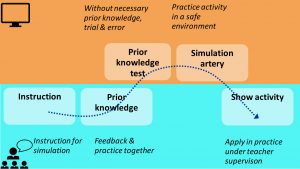Blended learning combines learning activities in class and remotely online. The most important aspect of blended learning is that all the activities are connected and support each other. “Blended learning represents a new approach and mix of classroom and online activities consistent with the goals of specific courses or programmes”(Garrison, Vaughan, 2008). An ideal blend in education does not exist. In each learning practice you will have to strive to find the most effective blend for that particular situation. This means that educational issues are leading, and not the technology as such.
The example below indicates how adding a prior-knowledge test, in this case an online test, helps students preparing for their learning experience in the simulation on the subject of artery. The teacher wanted to make sure the simulation would not been used as an trial and error environment by students, therefore the prior knowledge test was made a compulsory part of the programme.

Getting started
There are different ways to provide student with online material; you can offer them digital learning material (films, articles, websites) or provide them with weblectures, knowledge clips, online aassignments, online feedback/peer feedback assignments or online discussion platforms. Also using digital educational tools, such as the peer review tool Pitch2Peer, is a possibility.
As mentioned above, the main question here is still what are the learning goals? How are you going to test the students and how are you going to make sure you design your programme in such a way that it supports these goals?
When you first want to start with setting up a blended learning design, there are a few design principles to bear in mind.
- Start small; pilot your first redesign and evaluate under students;
- Something in, something out; try to avoid programme overload;
- Sequence the activities; put everything in an order and time line;
- Re-use; there is already a lot out there!
- Use lecture time differently; for discussion for example, or explaining more specific examples;
- Be clear; explain that the online part is part of the programme and not optional.
Resources
- D.R. Garrison, N.D. Vaughan (2008), Blended learning in higher education, Framework, Principles and Guidelines, Jossey-Bass, A Wiley Imprint, San Fransisco, CA. – This book provides a vision and roadmap for higher education faculty to understands the possibilities of organically blending face-to-face and online learning for engaging meaningful learning experiences.
- Randy Garrison, Heather Kanuka (2003), Blended learning: Uncovering its transformative potential in higher education, Learning Commons, Room 525, Biological Sciences Building, University of Calgary, 2500 University Drive NW, Calgary, Alberta, Canada T2N 1N4, Received 19 December 2003; accepted 13 February 2004, Internet and Higher Education 7 (2004) 95–105 –This article describes how blended learning has the potential to enhance both the effectiveness and efficiency of meaningful learning experiences.
- Associatie K.U. Leuven, Redactie: Luc Vandeput, bijdragen van Linda Tambuyser en Johannes De Gruyter (2011) Van e-learning naar geïntegreerd blended learning
